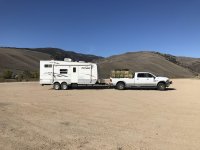The guy in the truck is stacking it the wrong way.....
He's loading hay just like I do in my truck, and just like everyone else does
 Attention: TDR Forum Junkies
Attention: TDR Forum Junkies The guy in the truck is stacking it the wrong way.....
He's loading hay just like I do in my truck, and just like everyone else does
This is what makes this avoidable accident even worse. Not to mention, miles of flat sagebrush desert.
The first runaway ramp is a few miles further up the highway also. It's approach seems to be on a more "level plane" compared to this last chance before arriving at intersection below.
It’s not how anyone I know stacks it, thou it’s close. The bottom bales are 90° to how they should be. If you roll them so they are taller you get a flatter stack on the upper bales, which puts less strain on them.

This....If the bottom bales are the “short” way the upper bales begin to break apart where they contact the bed rails, but if stacked on their side they don’t.
This....
My Dad purchased new a 1974 FoMoCo F-100 2wd long bed.
When harvesting hay, we would put four bales on their side near the headboard, three on their side between the wheel wells, and four on their side with the tailgate down......you know, the tailgate that had actual collapsible metal bars for the tailgate supports when lowered.
Many, many times we could get 53 bales of standard square size bales on the truck, and it rode well.
I was 10 years old in 1974. I didn’t do half bad tossing those “babies” around.Those were babiesprobably 14"x16"x36" 50-60# two string. Standard 3 string are 18"x22"x48" 100-120#
Our western state bales are 150lbs plus sometimes, and are much larger in weight and size. Everyone else strings up bales that weigh on average 80lbs.
I have a longbed truck with a full size chest tool box. I regularly stack 20 bales in my pickup and never tie them down, nor have I ever lost a bale....we maybe one or two here and there. I've tried various ways of stacking hay with a regular pickup bed and there is no other configuration on planet earth that will carry 16-20 150lb bales of hay securely
LOL, never worried about straining my hay bales but I guess I'll have to Google that now
Is that a wood framed interior on that old plane?






